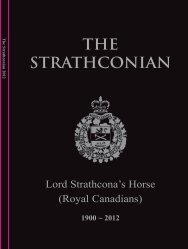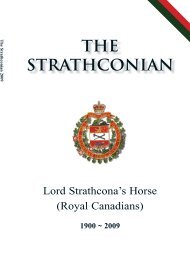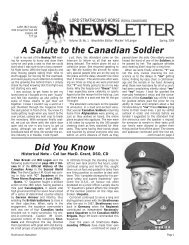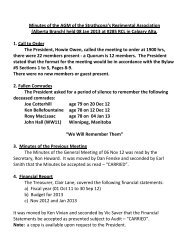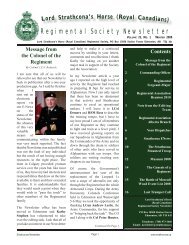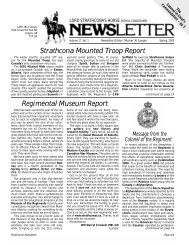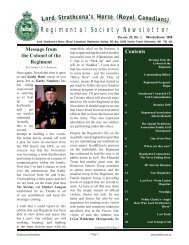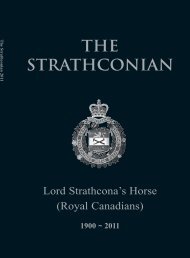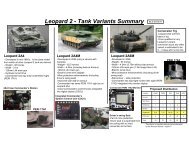The Regimental Manual Second Edition.pdf - Lord Strathcona's Horse
The Regimental Manual Second Edition.pdf - Lord Strathcona's Horse
The Regimental Manual Second Edition.pdf - Lord Strathcona's Horse
You also want an ePaper? Increase the reach of your titles
YUMPU automatically turns print PDFs into web optimized ePapers that Google loves.
REGIMENTAL MANUALHISTORY OF THE REGIMENTthe period 1965 to 1970 when the entire Regiment served in 4 CIBG in Germany. 22 During this periodthe Regiment was stationed at “Fort Beausejour” in Iserlohn, Germany. Of particular note during thislatter deployment was that B Squadron won the Canadian Army Trophy in 1967, NATO’s highest awardfor tank gunnery. Major-General F.F. Worthington, CB, MC, MM, CD, the “Father” of the RoyalCanadian Armoured Corps, then the Colonel Commandant, presented the award.5. On 26 July 1968, while the Regiment was stationed in Germany, Field Marshal Sir Richard Hull,KCB, DSO, a 17th/21st Lancer, presented a new Guidon. <strong>The</strong> old Guidon was laid up in Saint Stephen’sChurch in Calgary on 30 September 1970 following a parade in which the Regiment exercised theFreedom of the City. This ceremony reaffirmed the close ties that have existed with Calgary since 1920.6. On return to Canada, the Regiment was re-established in Calgary in June 1970, when the RegularForce component of <strong>The</strong> Fort Garry <strong>Horse</strong> was transferred to the Primary Reserve and its membersbecame Strathconas. Simultaneously the Regiment in Germany re-badged to <strong>The</strong> Royal CanadianDragoons. A number of these “originals” were posted in from Germany and elsewhere to join theRegiment in Calgary.ARTICLE 1106 - UNITED NATIONS DEPLOYMENTS1. Peacekeeping duties overseas have occupied alarge portion of the Regiment’s time in the modern era.From February 1957 to February 1958, men from <strong>Lord</strong>Strathcona’s <strong>Horse</strong> (Royal Canadians) and <strong>The</strong> RoyalCanadian Dragoons formed the 56 th CanadianReconnaissance Squadron that served in the newlyformed United Nations Emergency Force in Egypt.Other squadrons served in the same force during theperiods of February 1961 to February 1962 andFebruary 1963 to February 1964.2. In 1964/65, Reconnaissance Squadron served asix-month tour of duty with the United Nations Forcesin Cyprus (UNFICYP). <strong>The</strong> entire Regiment laterserved in Cyprus in a dismounted peacekeeping rolefrom April to October 1972, from September 1979 toApril 1980, and from August 1988 to March 1989. Inaddition, a reconnaissance troop was attached to theCanadian Airborne Regiment during the months of Julyto December 1974 as a result of the Turkish invasion ofCyprus. Another troop also served as theReconnaissance Troop with Third Regiment RoyalCanadian <strong>Horse</strong> Artillery as part of UNFICYP in 1982.Figure 8 – Reconnaissance Squadron Ferrets on Patrolin Cyprus, 1964/65 (<strong>Regimental</strong> Museum Archives)3. More recently, the Regiment also played major parts in modern-era peacekeeping missions.Twenty-eight Strathconas deployed on Operation MARQUIS to Cambodia in 1993 as part of the UnitedNations Transitional Authority in Cambodia (UNTAC). <strong>The</strong> following year, the Regiment deployed as aBattle Group to the Former Republic of Yugoslavia where it served as part of the United NationsProtection Force (UNPROFOR) in Bosnia-Herzegovina on Operation CAVALIER (Rotation 3) betweenApril and October 1994.22 Ibid. p. 224. 4 CIBG was designated 4 Canadian Mechanized Brigade Group on 1 May 1968.1-9



